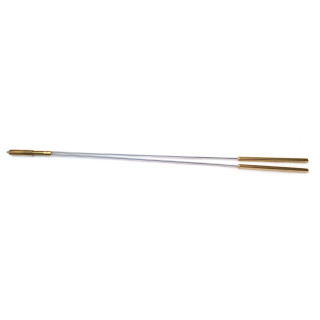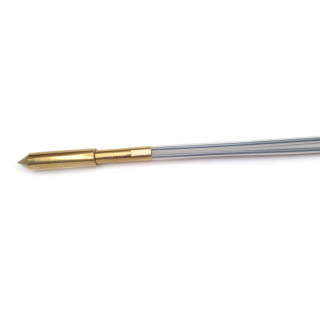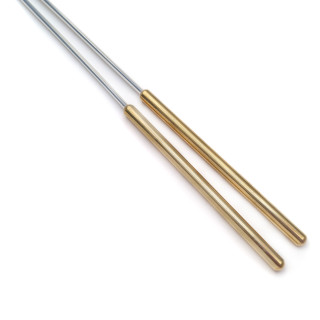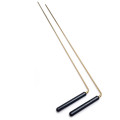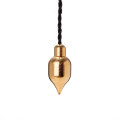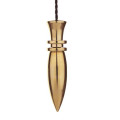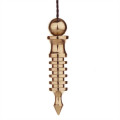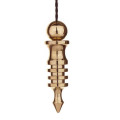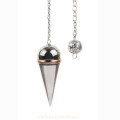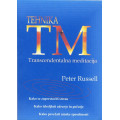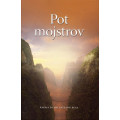A dowsing rod with a brass handle and an extended tip
Total length: 41,3 cm
Tip length: 5,80 cm
Material: brass handles and arms made of plasticized wire.
A dowsing rod is one of the oldest dowsing tools for finding underground water, minerals, metals and energy flows. It is a simple tool, usually in the shape of the letter Y or V, made of a wooden branch (most often hazel or willow wood), but it can also be made of metal or plastic. Dowsing rods are mostly used to find water and geopathic grids and places of power.
Usefulness of a dowsing rod
Detecting underground sources: a dowsing rod is traditionally used to find underground water sources or minerals.
Physical and energetic response: a dowsing rod responds to electromagnetic changes or vibrations underground. When the dowsing rod follows his intuition and the energy of the environment, it starts to move.
Working with energies: in addition to searching for water, the dowsing rod is also used to detect energy fields or geopathic networks that can negatively affect the health of people and animals. With a dowsing rod, dowsers can determine places that are suitable or unsuitable for building houses or placing sleeping quarters.
Method of use
Preparation and concentration: a dowser must first concentrate on what he wants to find (water, minerals, energy flows). He holds a dowsing rod so that his palms are facing upwards. He holds two arms as if to bend them outwards, while the third arm sticks forward. The elbows are close to the body. As he moves around the terrain, he holds a doswing rod relaxed but firm and watches her movements.
Reactions of the dowsing rod: when it detects what it is looking for, it may move down towards the ground, vibrate or turn. The dowser interprets this movement based on his experiences and the purpose of the search.
Using a doswing rod today
The dowsing rod is still used around the world, especially in finding underground water courses for wells in agricultural areas. In addition, dowsers search for energy flows in nature and spaces with a dowsing rod to improve the living environment and people's health.
A dowsing rod is therefore a simple but effective tool for finding invisible sources and energies.
Total length: 41,3 cm
Tip length: 5,80 cm
Material: brass handles and arms made of plasticized wire.
A dowsing rod is one of the oldest dowsing tools for finding underground water, minerals, metals and energy flows. It is a simple tool, usually in the shape of the letter Y or V, made of a wooden branch (most often hazel or willow wood), but it can also be made of metal or plastic. Dowsing rods are mostly used to find water and geopathic grids and places of power.
Usefulness of a dowsing rod
Detecting underground sources: a dowsing rod is traditionally used to find underground water sources or minerals.
Physical and energetic response: a dowsing rod responds to electromagnetic changes or vibrations underground. When the dowsing rod follows his intuition and the energy of the environment, it starts to move.
Working with energies: in addition to searching for water, the dowsing rod is also used to detect energy fields or geopathic networks that can negatively affect the health of people and animals. With a dowsing rod, dowsers can determine places that are suitable or unsuitable for building houses or placing sleeping quarters.
Method of use
Preparation and concentration: a dowser must first concentrate on what he wants to find (water, minerals, energy flows). He holds a dowsing rod so that his palms are facing upwards. He holds two arms as if to bend them outwards, while the third arm sticks forward. The elbows are close to the body. As he moves around the terrain, he holds a doswing rod relaxed but firm and watches her movements.
Reactions of the dowsing rod: when it detects what it is looking for, it may move down towards the ground, vibrate or turn. The dowser interprets this movement based on his experiences and the purpose of the search.
Using a doswing rod today
The dowsing rod is still used around the world, especially in finding underground water courses for wells in agricultural areas. In addition, dowsers search for energy flows in nature and spaces with a dowsing rod to improve the living environment and people's health.
A dowsing rod is therefore a simple but effective tool for finding invisible sources and energies.
No reviews found

